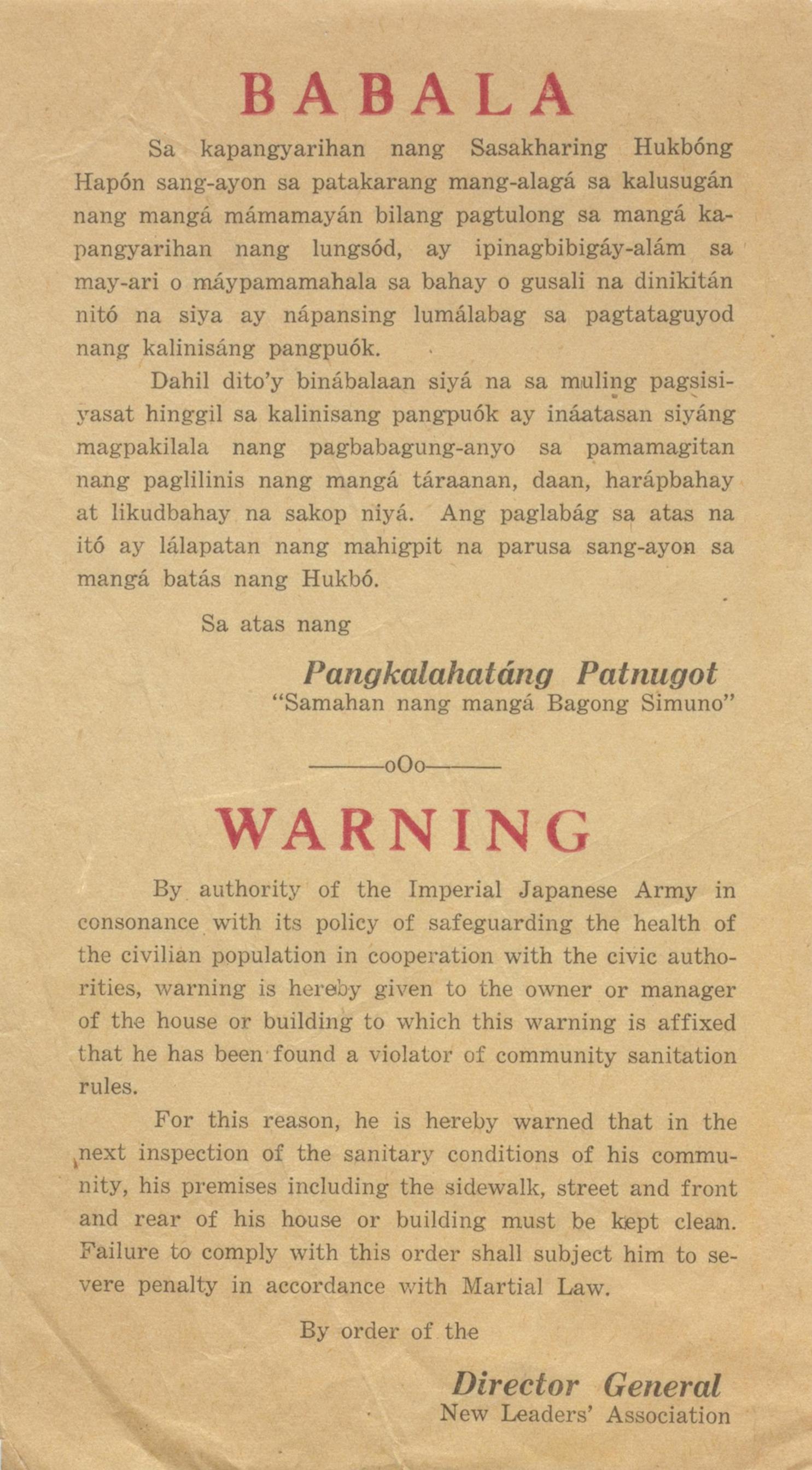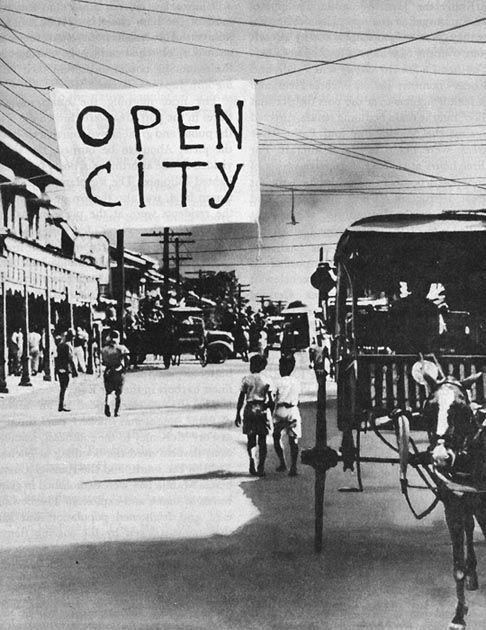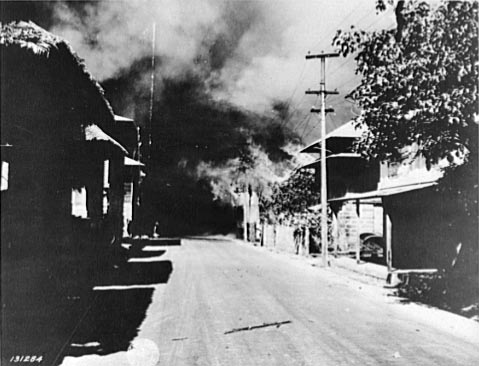|
Japanese Occupation Of The Philippines
The Japanese occupation of the Philippines ( Filipino: ''Pananakop ng mga Japones sa Filipinas''; ja, 日本のフィリピン占領, Nihon no Firipin Senryō) occurred between 1942 and 1945, when Imperial Japan occupied the Commonwealth of the Philippines during World War II. The invasion of the Philippines started on 8 December 1941, ten hours after the attack on Pearl Harbor. As at Pearl Harbor, American aircraft were severely damaged in the initial Japanese attack. Lacking air cover, the American Asiatic Fleet in the Philippines withdrew to Java on 12 December 1941. General Douglas MacArthur was ordered out, leaving his men at Corregidor on the night of 11 March 1942 for Australia, 4,000 km away. The 76,000 starving and sick American and Filipino defenders in Bataan surrendered on 9 April 1942, and were forced to endure the infamous Bataan Death March on which 7,000–10,000 died or were murdered. The 13,000 survivors on Corregidor surrendered on 6 May. Japan oc ... [...More Info...] [...Related Items...] OR: [Wikipedia] [Google] [Baidu] |
Filipino Language
Filipino (; , ) is an Austronesian language. It is the national language ( / ) of the Philippines, and one of the two official languages of the country, with English. It is a standardized variety of Tagalog based on the native dialect, spoken and written, in Metro Manila, the National Capital Region, and in other urban centers of the archipelago. The 1987 Constitution mandates that Filipino be further enriched and developed by the other languages of the Philippines. Filipino is only used as a tertiary language in the Philippine public sphere. Filipino, like other Austronesian languages, commonly uses verb-subject-object order, but can also use subject-verb-object order as well. Filipino follows the trigger system of morphosyntactic alignment that is also common among Austronesian languages. It has head-initial directionality. It is an agglutinative language but can also display inflection. It is not a tonal language and can be considered a pitch-accent language a ... [...More Info...] [...Related Items...] OR: [Wikipedia] [Google] [Baidu] |
Imperial Japanese Army
The was the official ground-based armed force of the Empire of Japan from 1868 to 1945. It was controlled by the Imperial Japanese Army General Staff Office and the Ministry of the Army, both of which were nominally subordinate to the Emperor of Japan as supreme commander of the army and the Imperial Japanese Navy. Later an Inspectorate General of Aviation became the third agency with oversight of the army. During wartime or national emergencies, the nominal command functions of the emperor would be centralized in an Imperial General Headquarters (IGHQ), an ad hoc body consisting of the chief and vice chief of the Army General Staff, the Minister of the Army, the chief and vice chief of the Naval General Staff, the Inspector General of Aviation, and the Inspector General of Military Training. History Origins (1868–1871) In the mid-19th century, Japan had no unified national army and the country was made up of feudal domains (''han'') with the Tokugawa shogunate (''bakuf ... [...More Info...] [...Related Items...] OR: [Wikipedia] [Google] [Baidu] |
Government In Exile Of The Commonwealth Of The Philippines
The Government of the Commonwealth of the Philippines in exile ( es, Gobierno de la Commonwealth de Filipinas en el exilio, tl, Pámahalaáng Kómonwélt ng Pilipinas sa pagpapatapón) was a continuation of the government of the Commonwealth of the Philippines after they had been evacuated from the country during World War II. The Commonwealth of the Philippines was self-governing, although under the ultimate control of the United States. During the conquest of the Philippines by the Empire of Japan, the government evacuated to Australia following the prior evacuation of U.S. General Douglas MacArthur in March 1942. From Australia they traveled to the United States, where they by May had established themselves in Washington, D.C. on 13 May 1942. While in Washington, the government, led by President Manuel L. Quezon, worked to maintain American interest in the Philippines, and issued shortwave broadcasts to the Philippines. Their legitimacy was supported by the U.S. government ... [...More Info...] [...Related Items...] OR: [Wikipedia] [Google] [Baidu] |
Sergio Osmeña
Sergio Osmeña Sr. (, ; 9 September 1878 – 19 October 1961) was a Filipino people, Filipino lawyer and politician who served as the List of presidents of the Philippines, fourth president of the Philippines from 1944 to 1946. He was Vice President of the Philippines, vice president under Manuel L. Quezon. Upon Quezon's sudden death in 1944, Osmeña succeeded him at age 65, becoming the oldest person to assume the Philippine presidency until Rodrigo Duterte took office in 2016 at age 71. A founder of the Nacionalista Party, Osmeña was also the first Visayan to become president. Prior to his accession in 1944, Osmeña served as governor of Cebu from 1906 to 1907, member and first speaker of the Philippine House of Representatives from 1907 to 1922, and senator from the Philippines's 10th senatorial district, 10th senatorial district for thirteen years, in which capacity he served as President pro tempore of the Senate of the Philippines, Senate president pro tempore. In 19 ... [...More Info...] [...Related Items...] OR: [Wikipedia] [Google] [Baidu] |
Manuel L
Manuel may refer to: People * Manuel (name) * Manuel (Fawlty Towers), a fictional character from the sitcom ''Fawlty Towers'' * Charlie Manuel, manager of the Philadelphia Phillies * Manuel I Komnenos, emperor of the Byzantine Empire * Manuel I of Portugal, king of Portugal Places *Manuel, Valencia, a municipality in the province of Valencia, Spain *Manuel Junction, railway station near Falkirk, Scotland Other * Manuel (American horse), a thoroughbred racehorse * Manuel (Australian horse), a thoroughbred racehorse *Manuel and The Music of The Mountains Geoffrey Love (4 September 1917 – 8 July 1991) was a prolific British arranger and composer of easy listening and pop versions of film themes. He became famous in the late 1950s, playing under the pseudonym of Manuel and The Music of The ..., a musical ensemble * ''Manuel'' (album), music album by Dalida, 1974 See also * Manny, a common nickname for those named Manuel {{disambiguation ... [...More Info...] [...Related Items...] OR: [Wikipedia] [Google] [Baidu] |
The Sunday Times (Western Australia)
''The Sunday Times'' is a tabloid Sunday newspaper published by Western Press Pty Ltd, a subsidiary of Seven West Media, in Perth and distributed throughout Western Australia. Founded as The West Australian Sunday Times, it was renamed The Sunday Times from 30 March 1902. Owned since 1955 by Rupert Murdoch's News Corp Australia and corporate predecessors, the newspaper and its website ''PerthNow'', were sold to Seven West Media in 2016.SWM finalises purchase of The Sunday Times . '' The West Australian'', 8 November 2016, page 3 History Established by[...More Info...] [...Related Items...] OR: [Wikipedia] [Google] [Baidu] |
Open City
In war, an open city is a settlement which has announced it has abandoned all defensive efforts, generally in the event of the imminent capture of the city to avoid destruction. Once a city has declared itself open the opposing military will be expected under international law to peacefully occupy the city rather than destroy it. According to the Protocol I of the Geneva Conventions, it is forbidden for the attacking party to "attack, by any means whatsoever, non-defended localities". The intent is to protect the city's civilians and cultural landmarks from a battle which may be futile. Attacking forces do not always respect the declaration of an "open city". Defensive forces will occasionally use the designation as a political tactic as well. In some cases, the declaration of a city to be "open" is made by a side on the verge of defeat and surrender; in other cases, those making such a declaration are willing and able to fight on but prefer that the specific city be spared. ... [...More Info...] [...Related Items...] OR: [Wikipedia] [Google] [Baidu] |
Manila Bay
Manila Bay ( fil, Look ng Maynila) is a natural harbor that serves the Port of Manila (on Luzon), in the Philippines. Strategically located around the capital city of the Philippines, Manila Bay facilitated commerce and trade between the Philippines and its neighboring countries,Jacinto, G.S., Azanza, R.V., Velasquez, I.B. and Siringan, F.P.(2006)."Manila Bay:Environmental Challenges and Opportunities" in Wolanski, E.(ed.) The Environment in Asia Pacific Harbours. Springer: Dordrecht, Netherlands. p309-328. becoming the gateway for socio-economic development even prior to Spanish occupation. With an area of , and a coastline of , Manila Bay is situated in the western part of Luzon and is bounded by Cavite and Metro Manila on the east, Bulacan and Pampanga on the north, and Bataan on the west and northwest.Jacinto, G.S., Velasquez, I.B., San Diego-McGlone, M.L., Villanoy, C.L. and Siringan, F.B.(2006)."Biophysical Environment of Manila Bay - Then and Now", in Wolanski, E.(e ... [...More Info...] [...Related Items...] OR: [Wikipedia] [Google] [Baidu] |
Bataan Peninsula
Bataan (), officially the Province of Bataan ( fil, Lalawigan ng Bataan ), is a province in the Central Luzon region of the Philippines. Its capital is the city of Balanga while Mariveles is the largest town in the province. Occupying the entire Bataan Peninsula on Luzon, Bataan is bordered by the provinces of Zambales and Pampanga to the north. The peninsula faces the South China Sea to the west and Subic Bay to the north-west, and encloses Manila Bay to the east. The Battle of Bataan is known in history as one of the last stands of American and Filipino soldiers before they were overwhelmed by the Japanese forces in World War II. The Bataan Death March was named after the province, where the infamous march started. History Classical Period The first inhabitants of the Bataan peninsula are the Ayta Magbeken people, who are one of the first Negrito ancestors of present-day Filipinos. Later on, Tagalog communities from southern Luzon migrated to parts of Bataan and the Ay ... [...More Info...] [...Related Items...] OR: [Wikipedia] [Google] [Baidu] |
Orlando Ward
Major General Orlando Ward (November 4, 1891 – February 4, 1972) was a career United States Army officer who fought in both World War I and World War II. During the latter, as a major general, he commanded the 1st Armored Division during Operation Torch and during the first few months of the Tunisian campaign, before being relieved in March 1943. He trained and returned to Europe in 1945 as commander of the 20th Armored Division. Ward also served as Secretary to the Army Chief of Staff, General George C. Marshall, in the critical years prior to the war and made major contributions to field artillery procedures in the 1930s that, a decade later, made the American field artillery especially effective in World War II. Early life and military career Born in Macon, Missouri, on November 4, 1891, Orlando Ward, at the age of 18, entered the United States Military Academy (USMA) at West Point, New York in 1909, graduating five years later (after being held back due to problems ... [...More Info...] [...Related Items...] OR: [Wikipedia] [Google] [Baidu] |
United States Armed Forces
The United States Armed Forces are the military forces of the United States. The armed forces consists of six service branches: the Army, Marine Corps, Navy, Air Force, Space Force, and Coast Guard. The president of the United States is the commander-in-chief of the armed forces and forms military policy with the Department of Defense (DoD) and Department of Homeland Security (DHS), both federal executive departments, acting as the principal organs by which military policy is carried out. All six armed services are among the eight uniformed services of the United States. From their inception during the American Revolutionary War, the U.S. Armed Forces have played a decisive role in the history of the United States. They helped forge a sense of national unity and identity through victories in the First Barbary War and the Second Barbary War. They played a critical role in the American Civil War, keeping the Confederacy from seceding from the republic and preserving ... [...More Info...] [...Related Items...] OR: [Wikipedia] [Google] [Baidu] |
United States Army
The United States Army (USA) is the land warfare, land military branch, service branch of the United States Armed Forces. It is one of the eight Uniformed services of the United States, U.S. uniformed services, and is designated as the Army of the United States in the United States Constitution, U.S. Constitution.Article II, section 2, clause 1 of the United States Constitution (1789). See alsTitle 10, Subtitle B, Chapter 301, Section 3001 The oldest and most senior branch of the U.S. military in order of precedence, the modern U.S. Army has its roots in the Continental Army, which was formed 14 June 1775 to fight the American Revolutionary War (1775–1783)—before the United States was established as a country. After the Revolutionary War, the Congress of the Confederation created the United States Army on 3 June 1784 to replace the disbanded Continental Army.Library of CongressJournals of the Continental Congress, Volume 27/ref> The United States Army considers itself to be ... [...More Info...] [...Related Items...] OR: [Wikipedia] [Google] [Baidu] |





